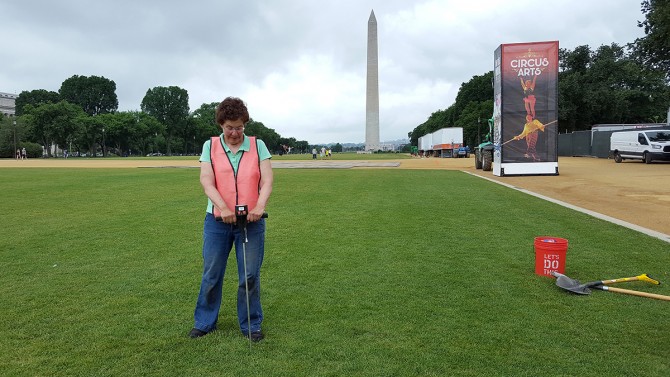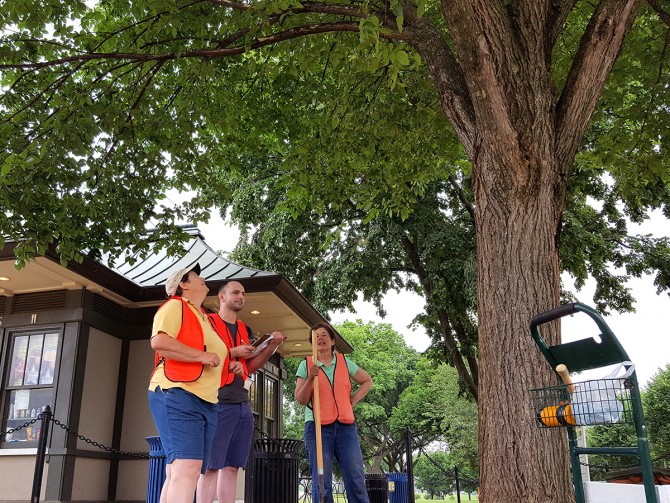Cornell scientist tapped to preserve elm trees on the National Mall
By Krisy Gashler
The elm trees that ring the National Mall in Washington, D.C., have stood witness to presidential inaugurations, given shaded respite to marchers and protestors, and provided millions of tourists with fresh air amid one of the busiest cities in the world.
But all that activity has taken its toll on the trees. A team of Cornell scientists is working to preserve the elms for generations to come.
“All the marches, all the inaugurations – there’s a huge amount of human impact along these panels of trees,” said Nina Bassuk, professor in the Horticulture Section of the School of Integrative Plant Science and director of Cornell’s Urban Horticulture Institute (UHI).
Bassuk is an expert in growing and strengthening trees in the most difficult city environments. In the spring, the National Park Service asked Bassuk to evaluate the trees on the Mall and develop a comprehensive plan to preserve them.
This is no easy task: In the corridor between the Washington Monument and the U.S. Capitol, there are roughly 600 trees, all of them either American elms or close hybrids. The homogeneity makes for striking visuals, but also leaves the trees more vulnerable to disease.
In June, Bassuk took a team to D.C.: horticulture graduate student Yoshiki Harada, UHI visiting fellow Bryan Denig and Cornell Cooperative Extension educator Barb Neal. They took measurements of the trees’ diameters and crowns, and assessed their health and risk of falling. They took more than 100 soil samples, sending half to the Cornell Soil Health Testing Laboratory to analyze the soil biological and physical processes, and using half to determine the soil’s bulk density, a measure of compaction.
“Some of the trees have Dutch elm disease, but by far the biggest issue is soil compaction,” Bassuk said. “The surface hardness of the soil is quite extreme, and even some of the soil compaction down deeper can be extreme.”
These results weren’t surprising to Bassuk: The Mall hosts approximately 24 million visitors per year, according to the National Park Service.
“The compaction is variable across the Mall, though – as you go toward the Capitol, it gets worse,” Bassuk said. “The Washington monument on the other side, it’s not as bad.”
Tests conducted by the Cornell Soil Health Testing Laboratory, which Bassuk called essential to gaining an overall prognosis for the trees, provided insights in the biological and physical processes happening in the soil, along with standard nutrient analysis. The tests revealed low amounts of organic matter that may have a negative impact on the trees, but it’s compaction that is most worrying, according to Bassuk.
Bassuk’s team continues to analyze the data they collected this summer, then they’ll start developing a management plan for the park service. Depending on the location, they may recommend air spading – a powerful tool that emits a jet of air to excavate the ground – to incorporate compost and de-compact the soil, getting rid of some grass, which competes with the trees for resources, or even radial trenching with a small backhoe.
“But we don’t want to hit the roots,” Bassuk said. “I have a sense that the roots are fairly shallow; you see a lot of roots right on the surface, but it would help us to know the extent of the biggest trees.”
To get a better sense of the roots, Bassuk is sending a colleague back to D.C. this fall with a ground-penetrating radar that can remotely locate the extent and depth of the roots without any potentially damaging digging. Gary Raffel of Dynamic Tree Systems will sample about 16 trees in different areas with the radar.
“This has been a somewhat unusual process – that the National Park Service came to me and wants this really quick turnaround,” she said. “We’re doing our best to fast-track this and keep these trees healthy. The Mall is like our nation’s front yard.”
Krisy Gashler is a freelance writer for the College of Agriculture and Life Sciences.
Media Contact
Get Cornell news delivered right to your inbox.
Subscribe
